#comte de vaudreuil
Explore tagged Tumblr posts
Text
Happy 4th of July, USA 🇺🇸

We were there. Make us proud.
#lesceptre #comtedevaudreuil #marineroyale #france
#4th of july#independance day#chesapeake#yorktown#comte de grasse#comte de vaudreuil#marquis de lafayette#usa#war of independence#revolutionary war#american revolution#france#quebec#marine#navy
5 notes
·
View notes
Text

comte de vaudreuil because I saw him at the VMFA and he looked very interesting
#comte de vaudreuil#frev art#frev#french revolution#my art#acrylic painting#actually proud of this#french history
5 notes
·
View notes
Text

Gentleman
The great hall: hier könnte auch William Wade, also Thomas Gainsboroughs Gemälde des Captains der englischen Navy, des Zeremonienmeisters oder Protokollchefs hängen, wenn es nicht woanders hängen müsste, nämlich in der Victoria Art Gallery.
In der großen (Eingangs-)Halle hängen gerade 10 Portraits und Doppelportraits im großen Stil. Gainsbororoughs Doppelportrait der Hallets und ihres Hundes, dessen Wischmopphaftigkeit derjenigen von Mrs. Hallets Frisur kaum nachsteht, hängt hier gleich ums Eck: links neben Drouais' Portrait des Comte de Vaudreuil.
Nahezu alle Portraits stammen aus der Phase, der Thomas Vesting in seiner Geschichte und Theorie der Rechtssubjekte die Figur des Gentleman zugeordnet hat (und die er mit William Wades Bild illustriert hat.
Wie singen die Groben in England zu dem Portrait?
All at once I was struck with the portrait of Wade,
Which tho’ like him in feature tis much too tall made
And looks, like its master – ashamed of its trade
For it’s drawn as if walking alone in the fields
In a jauntee undress which the present mode yields
Uncovered – as tho he intended to bow
To an ox or an ass – to a heffer or cow.
#vor dem bild#bilder bewegen#national gallery#prudentia bifrons#paarbildung#sir joshua reynolds#Francois Hubert Drouais#comte de vaudreuil#colonel tarleton
4 notes
·
View notes
Photo

Le Comte de Vaudreuil (detail), 1758, François-Hubert Drouais - oil on canvas
#2d art#paintings#clothing in art#era: 1700s#1750s#francois-hubert drouais#menswear#historical fashion#goldwork#sleeves#art details
160 notes
·
View notes
Text


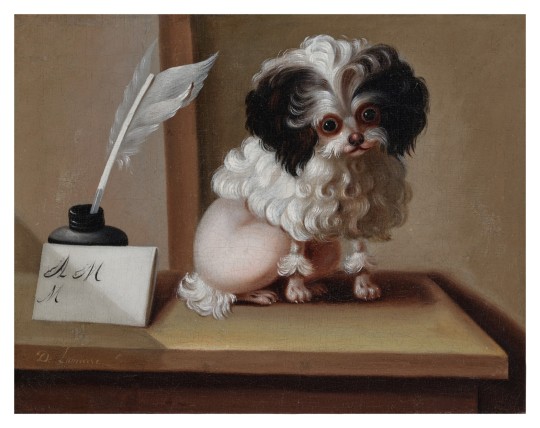
Trying to make sense of Delamarre and his painting of a dog said by someone (tho not anyone in history) to be Marie Antoinette's beloved Pompon, in the context of Marie Antoinette actually beloved painters, and it's not evening out.
L: Anne Vallayer-Coster's best still life, she got a studio in the Louvre and a stipend from M-A. R: Elisabeth Louise Vigee le Brun's portrait of the comte de Vaudreuil, her patron, who slept his way to power at Versailles, which led to her becoming the favorite portraitist of the queen and her groupies. Bottom: Delamarre's dog, supposedly Pompon, bless his wide-eyed, shaved-ass soul
#painters to the queen#anne vallayer-coster#elisabeth-louise vigée le brun#jacques barthélémy delamarre#pompon the purported beloved dog of marie antoinette#who was alas never mentioned in any of her biographies or memoires of her people
9 notes
·
View notes
Text

this is the place that my research project has led me
12 notes
·
View notes
Text
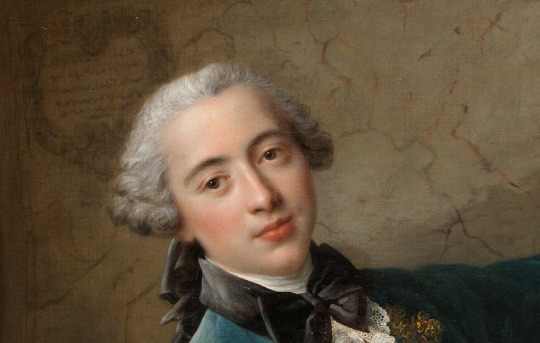


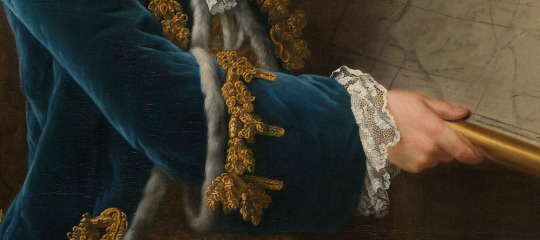
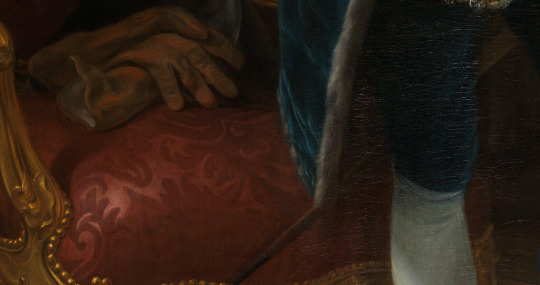

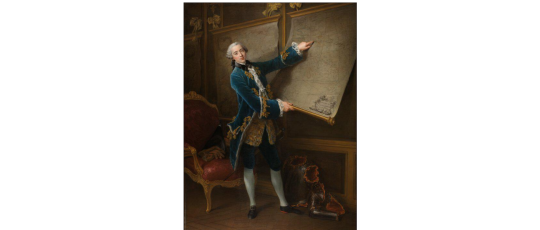
The Comte de Vaudreuil by François-Hubert Drouais, 1758. If you go to the link you can zoom in on it even more. Vaudreuil was a real character.
91 notes
·
View notes
Photo

Elizabeth Louise Vigée Le Brun - Portrait of Joseph Hyacinthe François de Paule de Rigaud, Comte de Vaudreuil (1740–1817)
2 notes
·
View notes
Text
JACOBIN FICTION CONVENTION MEETING 1: La Seine no Hoshi (1975)
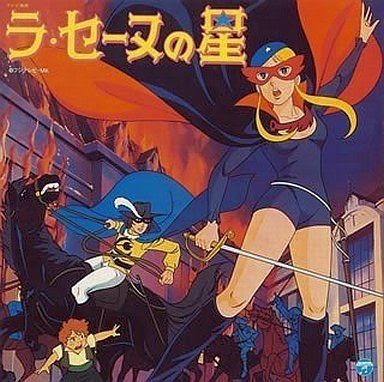
1. Introduction
Well, dear reader, here it is. My first ever official review. And, as promised, this is one of the pieces of Frev media that you have likely never heard of before.
So, without further ado, sit down, relax, grab drinks and snacks and allow me to tell you about an anime called “La Seine no Hoshi” (The Star of the Seine).
“La Seine no Hoshi” is a children’s anime series made by Studio Sunrise. It consists of 39 episodes and was originally broadcast in Japan from April 4th to December 26th of 1975.
Unlike its more famous contemporary, a manga called “Rose of Versailles” that had begun being released in 1972 and is considered a classic to this day, “La Seine no Hoshi” has stayed relatively obscure both in the world of anime and among other Frev pop culture.
Personally, the only reason why I found out about its existence was the fact that I actively seek out everything Frev-related and I just happened to stumble upon the title on an anime forum several years ago.
So far, the anime has been dubbed into Italian, French, German and Korean but there is no English or even Spanish dub so, unfortunately, people who do not speak fluent Japanese or any other aforementioned language are out of luck ( if anyone decides to make a fandub of the series, call me). That being said, the series is readily available in dubs and the original version on YouTube, which is where I ended up watching it. The French dub calls the anime “La Tulipe Noire” (The Black Tulip), which could be an homage to the movie with the same name that takes place in the same time period.
Unfortunately, while I do speak Japanese well enough to maintain a basic conversation and interact with people in casual daily situations, I’m far from fluent in the language so the version I watched was the French dub, seeing as I am majoring in French.
So, with all of this info in mind, let’s find out what the story is about and proceed to the actual review.
2. The Summary
(Note: Names of the characters in the French dub and the original version differ so I will use names from the former since that’s what I watched)
The story of “La Seine no Hoshi” revolves around a 15-year old girl called Mathilde Pasquier - a daughter of two Parisian florists who helps her parents run their flower shop and has a generally happy life.
But things begin to change when Comte de Vaudreuil, an elderly Parisian noble to whom Mathilde delivers flowers in the second episode, takes her under his wing and starts teaching her fencing for an unknown reason and generally seems to know more about her than he lets on.
Little does Mathilde know, those fencing lessons will end up coming in handy sooner than she expected. When her parents are killed by corrupt nobles, the girl teams up with Comte de Vaudreuil’s son, François, to fight against corruption as heroes of the people, all while the revolution keeps drawing near day by day and tensions in the city are at an all time high.
This is the gist of the story, dear readers, so with that out of the way, here’s the actual review:
3. The Story
Honestly, I kind of like the plot. It has a certain charm to it, like an old swashbuckling novel, of which I’ve read a lot as a kid.
The narrative of a “hero of the common folk” has been a staple in literature for centuries so some might consider the premise to be unoriginal, but I personally like this narrative more than “champion of the rich” (Looking at you, Scarlet Pimpernel) because, historically, it really was a difficult time for commoners and when times are hard people tend to need such heroes the most.
People need hope, so it’s no surprise that Mathilde and François (who already moonlights as a folk hero, The Black Tulip) become living legends thanks to their escapades.
Interestingly enough, the series also subverts a common trope of a hero seeking revenge for the death of his family. Mathilde is deeply affected by the death of her parents but she doesn’t actively seek revenge. Instead, this tragedy makes the fight and the upcoming revolution a personal matter to her and motivates her to fight corruption because she is not the only person who ended up on its receiving end.
The pacing is generally pretty good but I do wish there were less filler episodes and more of the overarching story that’s dedicated to the secret that Comte de Vaudreuil and Mathilde’s parents seem to be hiding from her and maybe it would be better if the secret in question was revealed to the audience a bit later than episode 7 or so.
However, revealing the twist early on is still an interesting narrative choice because then the main question is not what the secret itself is but rather when and how Mathilde will find out and how she will react, not to mention how it will affect the story.
That being said, even the filler episodes do drive home the point that a hero like Mathilde is needed, that nobles are generally corrupt and that something needs to change. Plus, those episodes were still enjoyable and entertaining enough for me to keep watching, which is good because usually I don’t like filler episodes much and it’s pretty easy to make them too boring.
Unfortunately, the show is affected by the common trope of the characters not growing up but I don’t usually mind that much. It also has the cliché of heroes being unrecognizable in costumes and masks, but that’s a bit of a staple in the superhero stories even today so it’s not that bothersome.
4. The Characters
It was admittedly pretty rare for a children’s show to have characters who were fleshed out enough to seem realistic and flawed, but I think this series gives its characters more development than most shows for kids did at the time.
I especially like Mathilde as a character. Sure, at first glance she seems like a typical Nice Pretty Ordinary Girl ™️ but that was a part of the appeal for me.
I am a strong believer in that a character does not need to be a blank slate or a troubled jerk to be interesting and Mathilde is neither of the above. She is essentially an ordinary girl with her own life, family, friends, personality and dreams and, unfortunately, all of that is taken away from her when her parents are killed.
Her initial reluctance to participate in the revolution is also pretty realistic as she is still trying to live her own life in peace and she made a promise to her parents to stay safe so there’s that too.
I really like the fact that the show did not give her magic powers and that she was not immediately good at fencing. François does remark that her fencing is not bad for a beginner but in those same episodes she is clearly shown making mistakes and it takes her time to upgrade from essentially François’s assistant in the heroic shenanigans to a teammate he can rely on and sees as an equal. Heck, later there’s a moment when Mathilde saves François, which is a nice tidbit of her development.
Mathilde also doesn’t have any romantic subplots, which is really rare for a female lead.
She has a childhood friend, Florent, but the two are not close romantically and they even begin to drift apart somewhat once Florent becomes invested in the revolution. François de Vaudreuil does not qualify for a love interest either - his father does take Mathilde in and adopts her after her parents are killed so François is more of an older brother than anything else.
Now, I’m not saying that romance is necessarily a bad thing but I do think that not having them is refreshing than shoehorning a romance into a story that’s not even about it. Plus most kids don’t care that much for romance to begin with so I’d say that the show only benefits from the creative decision of not setting Mathilde up with anyone.
Another interesting narrative choice I’d like to point out is the nearly complete absence of historical characters, like the revolutionaries. They do not make an appearance at all, save for Saint-Just’s cameo in one of the last episodes and, fortunately, he doesn’t get demonized. Instead, the revolutionary ideas are represented by Florent, who even joins the Jacobin Club during the story and is the one who tries to get Mathilde to become a revolutionary. Other real people, like young Napoleon and Mozart, do appear but they are also cameo characters, which does not count.
Marie-Antoinette and Louis XVI are exceptions to the rule.
(Spoiler alert!)
Marie-Antoinette is portrayed as kind of spoiled and out of touch. Her spending habits get touched on too but she is not a malicious person at heart. She is simply flawed. She becomes especially important to the story later on when Mathilde finds out the secret that has been hidden from her for her entire life.
As it turns out, Marie- Antoinette, the same queen Mathilde hated so much, is the girl’s older half-sister and Mathilde is an illegitimate daughter of the Austrian king and an opera singer, given to a childless couple of florists to be raised in secret so that her identity can be protected.
The way Marie-Antoinette and Mathilde are related and their further interactions end up providing an interesting inner conflict for Mathilde as now she needs to reconcile this relationship with her sister and her hatred for the corruption filling Versailles.
The characters are not actively glorified or demonized for the most part and each side has a fair share of sympathetic characters but the anime doesn’t shy away from showing the dark sides of the revolution either, unlike some other shows that tackle history (*cough* Liberty’s Kids comes to mind *cough*).
All in all, pretty interesting characters and the way they develop is quite realistic too, even if they could’ve been more fleshed out in my opinion.
5. The Voice Acting
Pretty solid. No real complaints here. I’d say that the dub actors did a good job.
6. The Setting
I really like the pastel and simple color scheme of Paris and its contrast with the brighter palette of Versailles. It really drives home the contrast between these two worlds.
The character designs are pretty realistic, simple and pleasant to watch. No eyesores like neon colors and overly cutesy anime girls with giant tiddies here and that’s a big plus in my book.
7. The Conclusion
Like I said, the show is not available in English and those who are able to watch it might find it a bit cliché but, while it’s definitely not perfect. I actually quite like it for its interesting concept, fairly realistic characters and a complex view of the French Revolution. I can definitely recommend this show, if only to see what it’s all about.
Some people might find this show too childish and idealistic, but I’m not one of them.
I’m almost 21 but I still enjoy cartoons and I’m fairly idealistic because cynicism and nihilism do not equal maturity and, if not for the “silly” idealism, Frev itself wouldn’t happen so I think shows like that are necessary too, even if it’s just for escapism.
If you’re interested and want to check it out, more power to you.
Anyway, thank you for attending the first ever official meeting of the Jacobin Fiction Convention. Second meeting is coming soon so stay tuned for updates.
Have a good day, Citizens! I love you!
- Citizen Green Pixel
#review#french revolution#anime#history#television#frev media#Jacobin Fiction Convention#marie antoinette#French Revolution anime#la seine ni hoshi#la tulipe noire dessin animé#la tulipe noire
25 notes
·
View notes
Photo
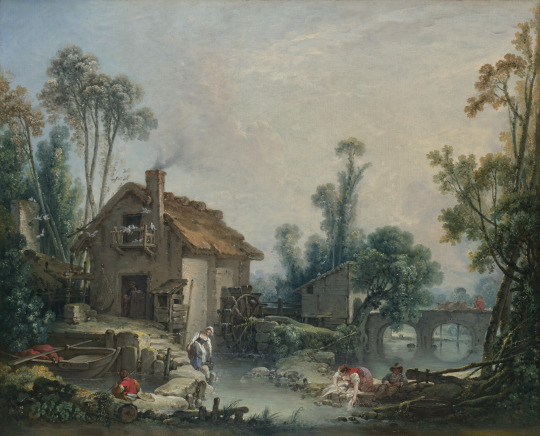
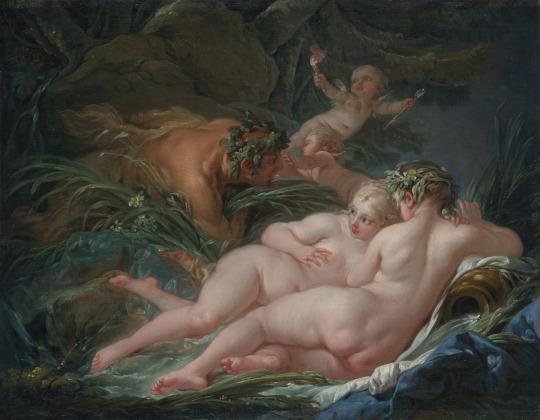
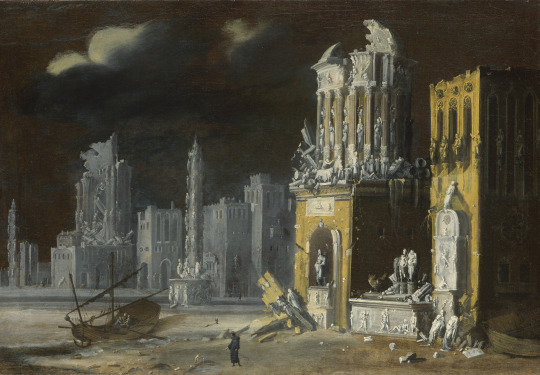
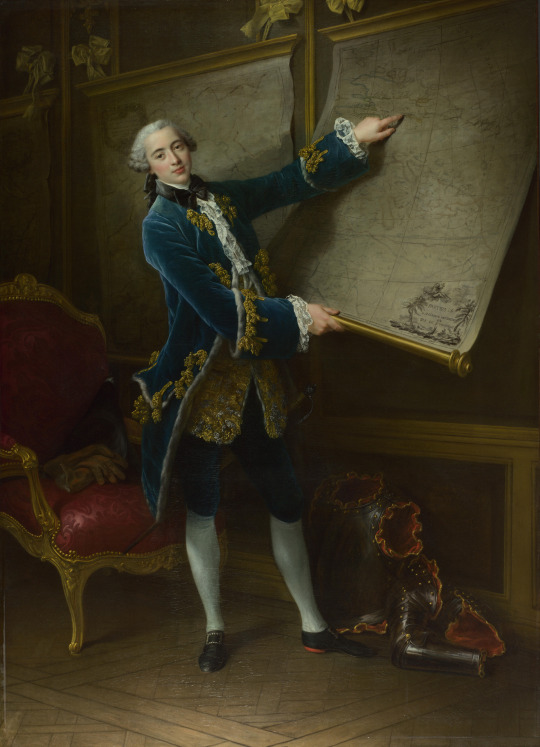
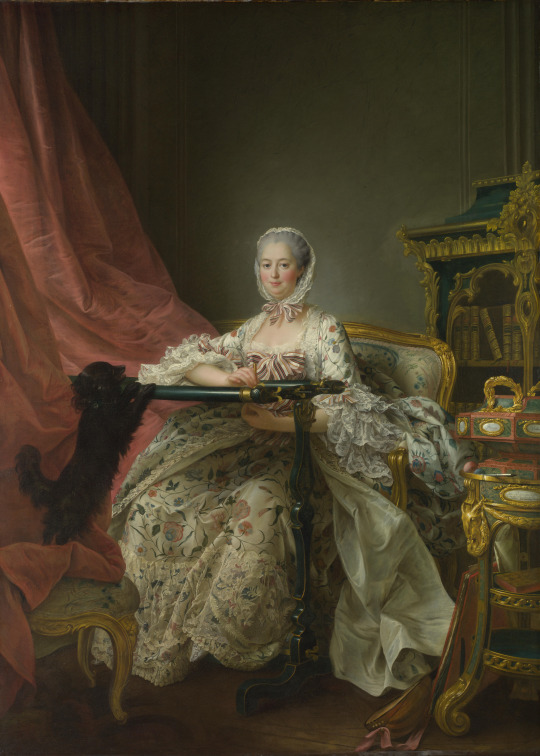
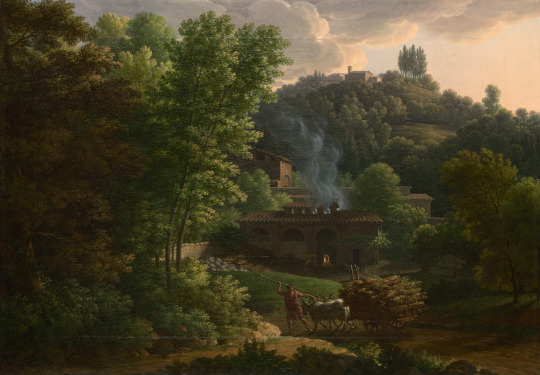
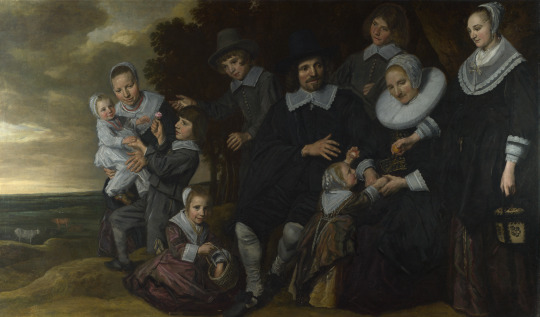

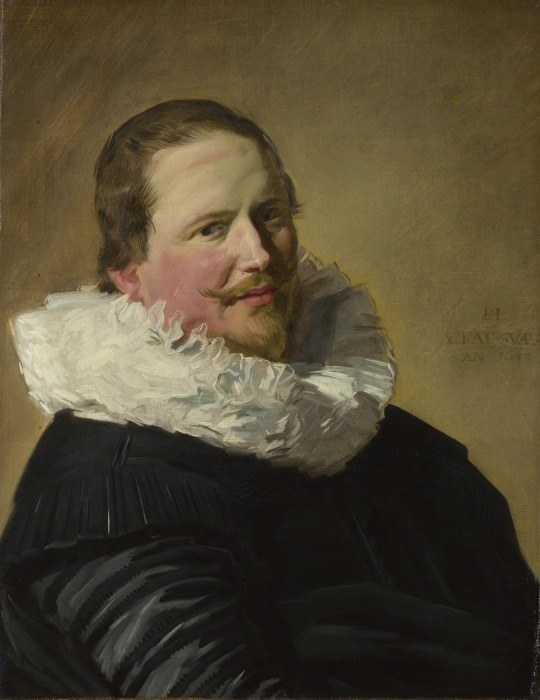
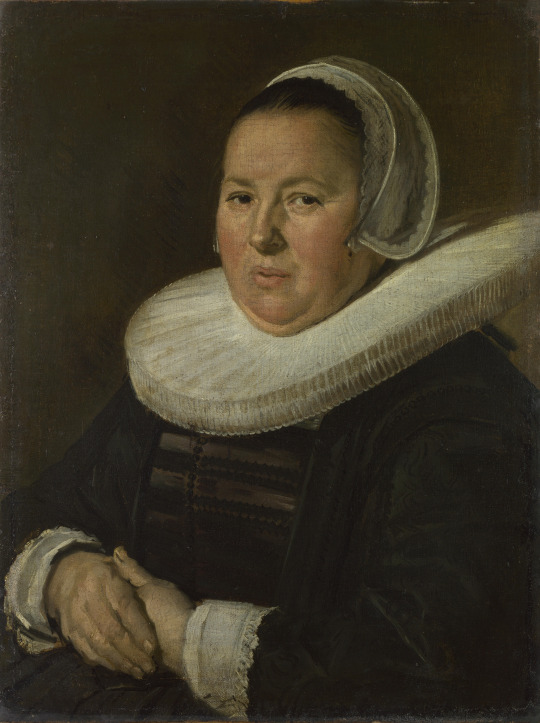
Лондонская Национальная галерея
7 notes
·
View notes
Text

"Combat de l'Intrépide s’élançant au secours du Tonnant" - 1747 (Versailles)
Le Tonnant lui-même, que montait M. (le Marquis) de L'Etanduère, avait reçu huit cents boulets et avait plus de cent tués ou blessés à son bord. Poursuivi par six vaisseaux ennemis à la fois, dégarni de ses mâts, de ses vergues, et faisant eau de toutes parts, il allait se rendre ou périr, lorsque le comte (Louis-Philippe) de Vaudreuil monté sur l'Intrépide, et commandant l'avant-garde française, s'élance au secours du Tonnant, passe a travers les vaisseaux anglais, en leur lâchant une double bordée, et vient fièrement se placer dans les eaux de son chef d'escadre. Seul, et bien qu'il comptât plus de cent-trente hommes baignés dans leur sang l'Intrépide tient tête à toute la flotte anglaise. II était huit heures et demie du soir. Étonnés du majestueux dévouement de I'lntrépide, non moins qu'épuisés par une lutte si meurtrière, les Anglais abandonnèrent la partie. Sans attendre le retour dans le port, M. de L'Etanduère écrivit, de son bord, à M. de Vaudreuil la lettre suivante :
"Mon cher Vaudreuil jamais manoeuvre n'a été plus belle, plus fière et plus distinguée que celle que vous avez faite. Vous m'avez tiré d'affaire avec un nombre de vaisseaux contre lesquels j'aurais été obligé de céder à la force. Nous pouvons dire que nous avons bien fait la manoeuvre des convois, qui est de se faire hacher pour sauver la flotte.
Je vous embrasse, mon cher Vaudreuil, de tout mon coeur; je fais mes amitiés à tout votre état-major et je vous remercie de votre bon secours."
Pour prix de sa bravoure, M. de Vaudreuil fut éle- vé, le 1'" avril 1748, au grade de chef d'escadre. Louis XV fit faire un tableau représentant l'Intrépide aux prises avec l'escadre anglaise. La copie de ce tableau existe au Musée de Versailles.
. . .
En: Battle of Cape Finisterre (October 1747), of the ship Intrepid against several British ships under Lord Admiral Edward Hawke.
Fr : Bataille du Cap Finisterre (octobre 1747), du navire l'Intrepide contre l'escadre anglaise d'Edward Hawke.
Louis-Philippe de Vaudreuil est né le 26 septembre 1691 à Québec.
2 notes
·
View notes
Text
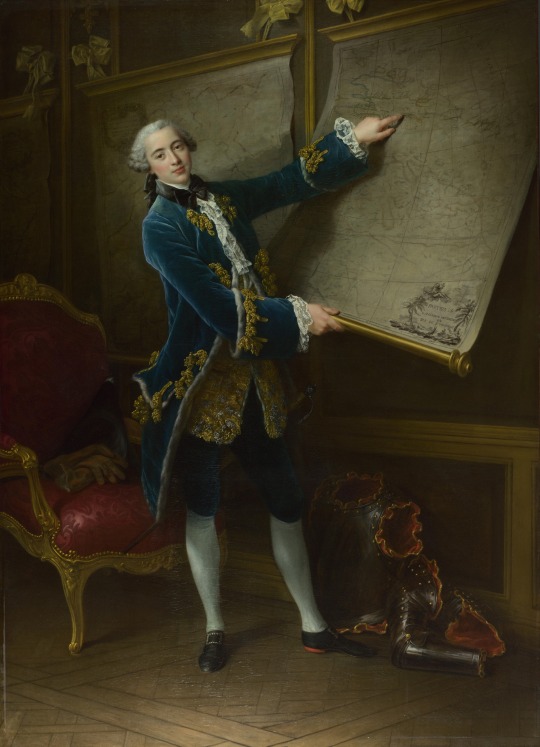
These spectacular portraits by Francois-Hubert Drouais are in London's National Gallery. Above, Portrait of the Comte de Vaudreuil. Below, Madame de Pompadour at her Tambour Frame.
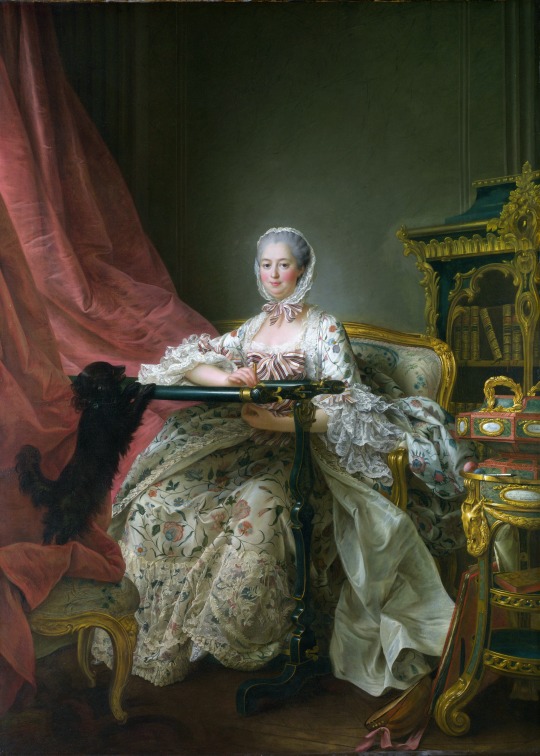
154 notes
·
View notes
Note
Ooh, the story about the two women falling into a lesbian folie a deux and going into one of Marie Antoinette's re: your tags sounds interesting! Can you share?
This is all very sketchy but it’s compelling alas.
Uh, so it’s called the Moberly-Jourdain incident. Happened in 1901. Two women, Charlotte Anne Moberly and Eleanor Jourdain visited the Palace of Versailles and the grounds. They went to visit the Petit Trianon but got lost on their way there. This is when weird things started occurring. As they tried to find the path back, they started seeing a lot of weird things that hadn’t been there before: ramshackled old cottages with linen hanging out of the windows, strangely dressed gardeners who gave them directions and a creepy looking scarred man (who they later decided, after studying some history books, was the Comte de Vaudreuil. There was also a change of mood in the air too, like a depression had suddenly come over the both of them and they noticed how everything seemed more like a waxwork than real life, with even the sunlight feeling artificial. A man in a straw hat eventually showed them the way to the Petit Trianon and when they came to it, they saw a small party of people and a lady sketching in the long grass. In the book they published about this event, she is described as having seemed like she was supposed to be attractive but had something unnerving about her that made it weird to look at her. Later, the women concluded this was Marie Antoinette herself, and claimed she looked exactly like (including her dress) Wertmuller’s famous picture of her walking with her two children, which is often described as being one of the most accurate portrait representations of Marie Antoinette’s appearance. After this, the weirdness seems to have ended when they came across a normal dressed party of people, toured the Trianon and went for some tea. They didn’t really talk about anything they saw with each other.
A week goes by and Moberly is recounting her Parisian trip to her sister in great detail, in a letter; when she gets to the day they visited Versailles, she supposedly turned to Jourdain and asked her if she thought Versailles was haunted and Jourdain said she did. They realised they had both had a similar spooky experience when they got lost on their way to the Petit Trianon and decided to do some research into the history (I also should mention that they claim they returned to Versailles to see if they saw the same things again and to make sure there hadn’t been a special event on that day) and also write down exactly what they had seen in that small window of time, without consulting each other. From both their accounts, they discovered they had seen different things, or not seen things that the other had. They also discovered that the day they visited the Trianon (the 10 August) was the anniversary of the day, in 1792, when the Tuileries palace was besieged and the Swiss guard massacred. You might be thinking ‘Wait, but that has nothing to do with what they saw! They saw Marie Antoinette drawing and relaxing!’ and to that, I say: this is where it gets really, really weird. They concluded that they hadn’t exactly gone back in time, but rather, entered Marie Antoinette’s memory. They were inside Marie Antoinette’s head on 10th August 1792, observing her fond but now sad memory of a happy day at the Petit Trianon years earlier. It’s crazy, I know, but makes….sense in the weirdest way. They decided that this also explained why they had suddenly felt depressed and sombre and why some people they came across had appeared frightening (the Comte de Vaudreuil for example) and others not. Anyway, they published a book about their exploit in 1911, called The Adventure and it was very, very popular. It’s also really spooky, if you ever read it.
Many explanations have been put forward, from a sort of messed up time slip, to, of course, a lesbian folie-a-deux* (which is my favourite spin to put on the story, especially since Marie Antoinette herself was linked to women in her lifetime) but if you’re a sceptic like me, you’ll put it all down to very clever sensationalism and decide it was probably a very elaborate hoax. I still like the idea of it though.
* Folie-a-deux, I believe, is a form of psychosis, which is shared between two people at the same time; usually the people in question are close in some way.
22 notes
·
View notes
Photo

La Table d’Ogre a testé pour vous (tasted for you) L’Epigramme (15/20 Catégorie Bleu) Pas d'agneau à la carte car l'épigramme (au féminin) n'est pas qu'une satire. Le mot (au masculin) vient d'une gourde marquise demandant à son cuisinier de lui préparer les mêmes épigrammes dont ses invités se seraient régalés chez le comte de Vaudreuil la veille. No lamb à la carte because the epigram (female) is not just a satire. The word (male) comes from a cloddish marquise asking her cook to prepare the same epigrams that her guests would have enjoyed at the Count of Vaudreuil's the day before. Article (FR/EN) complet sur mon blog www.latabledogre.com Lien dans ma bio. N’hésitez pas à laisser votre avis. Leave your advice if you like. #atthetable #foodpassion #gastronogram #simplisticfood #chefoninstagram #gastronomy #gastronomie #foodpassion #gastronogram #simplisticfood #googlelocalguide #europelocalguides #restaurantes #restaurantreview #restaurantfood #restaurantquality #restaurantphotography #restaurantparis #restoparis #parisfood #parisfoodie #pariseats #bonneadresseparis #topparisresto #parisrestaurant #parisfoodguide #parisianlifestyle #parisblogger #parisphotography #epigramme (à L'Epigramme) https://www.instagram.com/p/B674i5Ho4Gp/?igshid=12n48v3h77wsl
#atthetable#foodpassion#gastronogram#simplisticfood#chefoninstagram#gastronomy#gastronomie#googlelocalguide#europelocalguides#restaurantes#restaurantreview#restaurantfood#restaurantquality#restaurantphotography#restaurantparis#restoparis#parisfood#parisfoodie#pariseats#bonneadresseparis#topparisresto#parisrestaurant#parisfoodguide#parisianlifestyle#parisblogger#parisphotography#epigramme
0 notes
Text
Lmao there’s this one letter from the comte d’Artois to his BFF the comte de Vaudreuil, right after the execution of Marie Antoinette where he’s essentially like “It’s so sad that they executed her!!! She was so nice to me!! There are so many things I could personally blame her for right now, but I’m so sad that I can’t remember what they are :)”
Like he and Antoinette were pals and Mercy-Argenteau, the Austrian ambassador to France, kept writing to Marie Thérèse of Austria like. “This Artois dickhead keeps inviting Her Majesty to his insane parties and making them both look like garbage people. Jesus Christ.”
And that’s why loads of people thought that Artois was the real father of Marie Antoinette’s kids, and people wrote long erotic rhyming poems like Les Amours de Charlot et Toinette.
6 notes
·
View notes
Text
Du hành xuyên thời không: 2 phụ nữ người Anh chứng kiến giai đoạn lịch sử bi thương của nước Pháp
Câu chuyện về hai người phụ nữ Anh vào đầu thế kỷ 20 đã đi lạc vào chiều không gian của thế kỷ 18, và cảm nhận được một đoạn lịch sử tang thương của nước Pháp dưới triều Vua Louis XVI. Trải nghệm của họ là một trong những chuyến du hành xuyên không nổi tiếng và gây chấn động nhất dư luận.
Tự thưởng một chuyến đi
Ngày 10/8/1901, hai nữ học giả người Anh là Anne Moberly 55 tuổi và Eleanor Jourdain, 38 tuổi đã tự thưởng cho mình một chuyến đi tới Pháp. Họ quyết định dành một ngày tham quan Cung điện Versailles. Anne Moberly là hiệu trưởng của trường Cao đẳng St. Hugh (Oxford, Anh), còn Eleanor Jourdain là nhà nghiên cứu lịch Sử kiêm Phó hiệu trưởng của trường.
Cả hai cùng chung niềm đam mê nghiên cứu lịch sử nước Pháp và rất ngưỡng mộ Cung điện Versailles - biểu tượng quyền lực của triều đại phong kiến Pháp. Cung điện Versailles nổi tiếng không chỉ bởi quy mô rộng lớn với tổng diện tích lên tới 67.000m2, mà còn bởi vẻ nguy nga, lộng lẫy hội tụ mọi tinh hoa nghệ thuật của nước Pháp trong thế kỷ 17 và 18.
[caption id=“attachment_710867” align=“alignnone” width=“549”] Cung điện Versailles. (Ảnh: blogspot.com)[/caption]
Với cuốn cẩm nang du lịch bỏ túi Baedeker, Anne Moberly và Eleanor Jourdain tự bắt xe tới Cung điện Versailles rộng lớn, nơi bao gồm một tổ hợp kiến trúc gồm Versailles, Grand Trianon và Petit Trianon.
Sau khi đi thăm cung điện chính Versailles, họ đi dạo quanh khu đất rộng rãi và Anne Moberly gợi ý muốn ghé thăm Petit Trianon, một lâu đài nhỏ do vua Louis XVI xây dành tặng người vợ 19 tuổi của mình, hoàng hậu Marie Antoinette. Cả hai đều không biết rằng, họ sắp được trải nghiệm đến một nơi lạ thường.
Chuyến tham quan kỳ dị
Petit Trianon cách cung điện Versailles gần một dặm, du khách phải đi qua những khu vườn rộng lớn, nơi có những con đường giao cắt, quanh co rải đầy lá vàng nối liền các cung điện với nhau.
Mặc dù có bản đồ chỉ dẫn, nhưng du khách người Anh vẫn chưa xác định được vị trí chính xác của Petit Trianon. Họ phân vân bị lạc đường khi nhận thấy đang đi trên một con đường nhỏ hẹp vắng lặng, bốn bề xung quanh u tịch lạ thường.
[caption id=“attachment_710876” align=“alignnone” width=“549”] Khu nghỉ hè Petit Trianon của hoàng hậu Marie (Ảnh: en.brilio.net)[/caption]
Họ đi qua một trang trại hoang vắng không bóng người và thấy một cái cày cũ nằm ở ven đường. Ngay lập tức, cô Moberly bắt đầu cảm thấy kỳ lạ, như thể một cơn trầm cảm đen tối đang bủa vây cô và cô thấy khá kỳ lạ là không có lý do gì để cô thay đổi tâm trạng, vì việc đi bộ đối với cô là khá thú vị, ngay cả khi họ bị lạc.
Xa xa thấp thoáng những ngôi nhà thấp lè tè, và khi lại gần, họ nhận ra đó là một ngôi làng khá đơn sơ. Khi đi qua một ngôi nhà nhỏ, Jourdain thấy có một người phụ nữ đang cầm một cái bình đưa cho cô gái, còn cô gái thì vươn tay lên đỡ lấy nó. Nhưng kỳ lạ ở chỗ là cảnh tượng cô nhìn thấy dường như hai người phụ nữ đang bị “đóng băng”.
[caption id=“attachment_710884” align=“alignnone” width=“536”] Quang cảnh ngôi làng tái hiện tại Petit Trianon ngày nay. (Ảnh: en.brilio.net)[/caption]
Moberly cảm nhận bầu không khí thay đổi mạnh mẽ, một thứ không gian ảm đạm, buồn bực xâm chiếm lấy cô. Cô viết: “Tất cả mọi thứ đột nhiên trở nên lạ lùng, khó chịu và phẳng lặng. Cây cối dường như không còn sức sống, không có gió khuấy động cây, cả không gian đều u mịch kỳ lạ nhuộm trong thứ ánh sáng chạng vạng của buổi chiều tà”.
Không chỉ Moberly mà Jourdain cũng chung cảm giác tù túng, như thể có một điều gì đó đang đè nén khiến tâm trạng họ cảm thấy vô cùng nặng nề. Họ tiếp tục đi bộ và nhìn thấy vài người mà họ nghĩ là người làm vườn trong cung điện. Sau đó, Moberly nhìn thấy hai người đàn ông trông rất trang nghiêm, mặc áo khoác màu xanh xám với mũ tri diềm đi ngang qua họ.
Họ đi theo con đường dẫn tới một vọng lâu rợp bóng cây. Dù quang cảnh vô cùng bình yên, nhưng khi tới đây, tâm trạng của cả hai thậm chí còn u ám hơn. Họ thấy một người đàn ông đứng cạnh vọng lâu, mặc một chiếc áo choàng dài và đội cái mũ lớn.
Trông ông ta khá điềm nhiên. Dù ông ta không nhìn họ, nhưng Moberly vẫn thấy bất an, đau đớn, và ghê sợ:“Cảm giác ngộp thở, ông ta thật đáng sợ. “Da ông ta sậm màu và thô ráp”. Khi ông ta từ từ quay mặt về phía Jourdain, cô nhìn thấy khuôn mặt lỗ rỗ vết sẹo di chứng của bệnh đậu mùa. “Da ông ta rất đen, còn biểu hiện thì vô cùng độc ác. Khi đi ngang qua ông ấy, tôi cảm nhận một sự ớn lạnh”, Jourdain viết trong bản ghi chép.
[caption id="attachment_710904” align=“alignnone” width=“488”] Vọng Lâu ngày nay tại Petit Trianon. (Ảnh: en.brilio.net)[/caption]
Ngay lúc ấy, bỗng có một người đàn ông trẻ dáng vẻ vội vã, cảnh báo họ đang đi sai đường bằng một giọng nói khá lạ. Họ không hiểu và vì vậy anh ta phải làm dấu hiệu chỉ dẫn họ đi qua một cây cầu thì mới tới Petit Trianon.
Họ tiếp tục đi trong yên lặng, hòa vào cái tĩnh mịch của vùng đất mà họ đã đi qua. Ðâu đâu cũng đều nhuốm vẻ thâm trầm, lặng lẽ. Họ đến nơi mà họ cho là Petit Trianon. Moberly bỗng nhìn thấy một người phụ nữ đang ngồi vẽ trong một khu vườn.
Moberly ghi lại: “Người phụ nữ đó mặc một chiếc váy mùa hè bồng bềnh, đội một chiếc mũ trắng cùng mái tóc công xù tuyệt đẹp”. Moberly bối rối và nghĩ rằng người phụ nữ ấy cũng là khách du lịch, tuy nhiên váy áo người ấy lỗi thời và trông khá lạ thường. Điều đáng nói là khi đứng tại khu vườn này, cả hai người phụ nữ lại trải qua một cảm giác u ám dữ dội.
[caption id="attachment_711012” align=“alignnone” width=“666”] Moberly nghĩ người phụ nữ ấy cũng là khách du lịch, tuy nhiên váy áo người ấy lỗi thời và trông khá lạ thường. (Ảnh: bitesizedtravel)[/caption]
Khi đến cuối con đường, họ nhìn thấy một tòa nhà và đột nhiên có một người lao ra khỏi đó và đóng sập cánh cửa phía sau lại. Người này nói với họ rằng lối vào Petit Trianon ở phía bên kia của tòa nhà và vì vậy họ đi quanh tòa nhà rồi nhìn thấy một bữa tiệc ồn ã. Trong suốt hành trình, đây là lần đầu tiên họ thấy cảnh tượng sống động như vậy.
Thấm mệt sau một hành trình dài, Anne Moberly và Eleanor Jourdain ngồi nghỉ trên một tảng đá lớn có hàng cây râm mát. Cuối giờ chiều họ quay trở về. Ðiều lạ thường là con đường họ đi qua vẫn còn đó, nhưng không còn tòa nhà náo nhiệt, không còn người đàn bà ngồi vẽ, không vọng lâu và cũng chẳng còn cây cầu, ngôi làng, nông trại…
Mọi thứ như tan biến vào hư không…
So sánh hồi ức
Hai phụ nữ trở về Anh mang theo tâm trạng hoang mang kỳ bí. Để khẳng định chắc chắn đây không phải là cơn mộng mị, họ quyết định mỗi người sẽ ghi lại những gì mình đã nhìn thấy. Sau khi xem các tập ghi chép của nhau, họ xác nhận rằng mỗi người đều cùng thấy rõ ràng những hình ảnh xác thực xảy ra trước mắt mình.
Nếu một người gặp phải hoàn cảnh ấy thì còn có thể cho là ảo giác, nhưng điều lạ thường ở đây chính là cả hai người đều cùng thấy những cảnh tượng như thế, ngoại trừ hai tình tiết: Trong khi Moberly nhìn thấy người phụ nữ vẽ tranh trên bãi cỏ, thì Jourdain lại không thấy. Còn khi Jourdain thấy người đàn bà lớn tuổi và cô gái ở túp lều thì Moberly lại không thấy.
Nhớ rằng, cả Anne Moberly và Eleanor Jourdain đều là học giả, xuất thân từ gia đình bảo thủ ở Anh vào đầu thế kỷ 20, nên họ hiểu rằng, nếu họ kể về trải nghiệm ở cung điện Versailles, sẽ gây ra một cuộc tranh cãi, thậm chí mang lại điều tiếng cho họ.
[caption id=“attachment_711022” align=“alignnone” width=“549”] Anne Moberly (ảnh trái) và Eleanor Jourdain (ảnh phải) đều là học giả, xuất thân từ gia đình bảo thủ ở Anh đầu thế kỷ 20. (Ảnh: toptenz.net)[/caption]
Vì vậy cả hai quyết định âm thầm quay trở lại Pettit Trianon lần nữa. 5 tháng sau, tháng 1/1902, họ đi theo đúng con đường nhỏ yên tĩnh ấy. Khi đến gần khu vườn, họ bỗng nghe thấy tiếng nhạc thoang thoảng và thấp thoáng đằng xa có hai công nhân đội mũ đỏ đang chất củi lên xe. Nhưng những cảnh tượng của lần trước thì không còn nữa.
Sau đó, cả hai đến gặp người trông coi khu Petit Trianon. Sau khi nghe họ kể lại những gì họ vừa thấy cũng như xem xét cuốn ghi chép, ông ta nói: “Tôi là người trực tiếp trông coi khu này đã lâu năm, nhưng chưa từng trông thấy những điều như hai cô mô tả”.
Nhận thấy những điều họ kể lại đều khó được chấp nhận, hai người phụ nữ quyết định tiến hành cuộc điều tra toàn diện của riêng mình để chứng minh những gì họ nhìn thấy là hoàn toàn chân thực. Hai bản chép tay họ viết năm 1901 được coi là tài liệu gốc cho cuộc điều tra.
Hé lộ nhiều tình tiết bí ẩn
Tìm hiểu qua các tài liệu lịch sử, xã hội và văn hóa nước Pháp, họ ghi nhận rằng trang phục mà họ thấy ở Pettit Trianon thuộc về triều đại vua Louis XVI (1774-1792).
[caption id=“attachment_711303” align=“alignnone” width=“670”] Bức tranh Chân dung Marie Antoinette của họa sĩ Wertmüller, (Ảnh: theprettycrusades.com)[/caption]
Khi xem bức tranh Chân dung Marie Antoinette của họa sĩ Wertmüller, Moberly quá kinh ngạc khi thấy quá giống với hình ảnh người phụ nữ ngồi vẽ ở khu vườn mà cô nhìn thấy ở Pettit Trianon, ngay cả trang phục cũng giống nhau. Cùng với những bức tranh khác ở thời kỳ ấy, họ khám phá ra người đàn ông độc ác mà họ nhìn thấy trong vọng lâu rất giống bức chân dung Comte de Vaudreuil, kẻ thù của Marie Antoinette.
Sự khác biệt duy nhất là ông ta có nước da sẫm màu trong khi bức tranh lại mô tả là người da trắng. Nhưng có một chi tiết gây thuyết phục, tài liệu lịch sử ghi chép Comte de Vaudreuil sinh ra ở Tây Ấn, và mẹ của ông sở hữu nước da sẫm màu.
Cũng tại vọng lâu này, họ đã gặp một người đàn ông trẻ trong bộ dạng lo lắng cảnh báo họ đi nhầm đường bằng chất giọng lạ. Sau này tìm hiểu tư liệu, họ mới biết anh ta nói tiếng Pháp cổ và chính là sứ giả đến Pettit Trianon để cấp báo cho Marie Antoinette biết có một đám đông sắp bao vây Versailles.
[caption id=“attachment_711313” align=“alignnone” width=“587”] Bức chân dung Comte de Vaudreuil, kẻ thù của Marie Antoinette. (Ảnh: en.brilio.net)[/caption]
Thông qua tra cứu lịch sử, họ biết rằng ngày 5/10/1789, Marie Antoinette đang ở Petit Trianon thì nhận được tin cấp báo rằng một đám đông từ Paris đang tiến về phía cổng cung điện Versailles. Sau đó đám đông người giận dữ bắt giữ Hoàng hậu và vua Louis XVI. Cũng chính tại đây, Marie Antoinette phải chứng kiến vụ thảm sát các vệ sĩ Thụy Sĩ của bà.
Bà cùng chồng bị buộc phải tới Cung điện hoàng gia tại Tuileries (Paris). Ngày 10/8/1792, đám đông tấn công cung điện Paris và bắt giam Marie Antoinette và vua Louis XVI. Điều khiến hai người phụ nữ kinh ngạc là: Đúng 109 năm sau, vào ngày 10/8, Moberly và Jourdain đến tham quan Versailles.
Đây có phải là một sự trùng hợp ngẫu nhiên, hay cho thấy trải nghiệm của họ là có thật? Điều này làm họ càng tin chắc rằng, bằng cách nào đó họ đã đi ngược thời gian vào một chiều không gian khác.
Hơn nữa, cả hai cho rằng, những ký ức của hoàng hậu Marie Antoinette khi phải đối mặt với những sự kiện kinh hoàng thời ấy, bằng cách nào đó đã tồn tại qua nhiều năm và họ vô tình tiếp nhận được. Điều này giải thích lý do vì sao trong khi đi dạo ở Petit Trianon, cả Moberly và Jourdain đều luôn cảm nhận một trạng thái u uất đen tối bủa vây họ.
[caption id=“attachment_711065” align=“alignnone” width=“586”] Khung gian ảm đạm ở Petit Trianon khiến Moberly và Jourdain luôn cảm nhận trạng thái u uất bủa vây họ. (Ảnh: en.brilio.net)[/caption]
Tháng 7/1904, Moberly và Jourdain quyết định trở lại Versailles lần nữa. Tuy nhiên không những không thấy cảnh tượng cũ, mà họ còn trông thấy rất nhiều khách du lịch. Điều này khác xa năm 1901, khi trong trải nghiệm ngược thời gian, họ không nhìn thấy bất cứ du khách nào.
Càng tìm hiểu, hai người phụ nữ càng thấy có nhiều điểm kỳ lạ nên họ đã gửi một lá thư đến Hội Nghiên cứu Tâm linh xin trợ giúp. Nhưng thời bấy giờ, không chỉ giới khoa học mà ngay cả những người nghiên cứu tâm linh cũng cho rằng câu chuyện của họ quá hoang đường, không phù hợp để điều tra.
Tuy nhiên câu chuyện này cũng lôi cuốn một số nhà nghiên cứu hiện tượng siêu hình và các nhà sưu tập sử liệu. Cùng với tập bút ký của hai người phụ nữ, họ đã góp phần tìm hiểu và phân tích những dữ liệu này.
Những gì mà hai nữ học giả nhìn thấy như ngôi làng, túp lều, nông trại và các nông cụ… thì trong tư liệu lịch sử ghi rằng, tháng 8/1784, hoàng hậu Marie Antoinette đã cho xây ngôi làng Hameau de la reine trong khu vườn của Petit Trianon như là một trang trại nhà nông với mái rơm, trại sữa, máy xay, nông trại nuôi chim, dê, bò sữa…
Cũng trong tài liệu này, có nhắc đến túp lều ở Trianon, nơi đây có người mẹ và cô con gái 14 tuổi sinh sống. Đó là hình ảnh mà Eleanor Jourdain nhìn thấy hai mẹ con trong tư thế “đóng băng”.
Cả hai đã nhìn thấy cái cày ven đường, nhưng trong các chuyến trở lại Versailles để tìm kiếm thêm manh mối, họ không thấy có. Tuy nhiên, một cái cày cũ đã được trưng bày ở bảo tàng cho thấy nó được sử dụng ở Petit Trianon năm 1789.
Về cây cầu mà hai người phụ nữ đã đi qua không tồn tại ở Petit Trianon vào năm 1901, nhưng trong tư liệu bản vẽ chi tiết địa danh vùng Petite Trianon khi xưa do người làm vườn của Hoàng Hậu Marie Antoinette vẽ, có hình cây cầu vắt ngang qua con suối.
Cả hai cùng nhìn thấy những người đàn ông mặc áo khoác xanh xám và đội mũ tri diềm. Họ chính là lính cận vệ mặc đồng phục Thụy Sĩ của hoàng hậu Marie Antoinette.
[caption id=“attachment_711134” align=“alignnone” width=“458”] Hoàng hậu Marie Antoinette và vua Louis XVI. (Ảnh: timetoast.com)[/caption]
Họ thấy một người chạy bộ ra khỏi tòa nhà và đóng sầm cửa lại sau lưng. Tuy nhiên, thực tế vào thời điểm họ tham quan năm 1901, cánh cửa này bị đóng lại không cho du khách sử dụng đã nhiều năm.
Tất cả dữ kiện cho thấy Moberly và Jourdan bằng cách nào đó đã du hành ngược thời gian mà bản thân họ cũng không ngờ tới. Năm 1911, họ cho ra mắt cuốn sách có tiêu đề là An Adventure kể về trải nghiệm kỳ lạ này. Nhưng do lo lắng xảy ra tranh cãi, họ ẩn danh lấy bút danh là Elizabeth Morrison và Frances Lamont.
Cuốn sách ra mắt không khác gì bom tấn gây chấn động dư luận xã hội, khi những vấn đề tâm linh còn ít người dám đề cập một cách công khai. Những người hoài nghi cho rằng hai tác giả bị rối loạn tâm thần. Nhưng cũng có khá nhiều học giả trí thức và giới nghệ sĩ, trong đó có nhà thơ, nhà viết kịch, nhà sản xuất phim nổi tiếng Jean Cocteau đã gọi đó là “Sự kiện quan trọng nhất trong lịch sử” và hoàn toàn tin trải nghiệm ấy là có thật.
Xuân Trường
from Đại Kỷ Nguyên - Feed - http://bit.ly/2VZUDTy via http://bit.ly/2VZUDTy https://www.dkn.tv from Đại Kỷ Nguyên http://bit.ly/2TSYuQz via IFTTT
0 notes